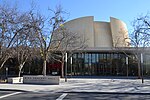Frost Amphitheater
1937 establishments in CaliforniaAmphitheaters in CaliforniaMusic venues completed in 1937Music venues in the San Francisco Bay AreaStanford University buildings and structures

The Laurence Frost Amphitheater, commonly known as Frost Amphitheater, is a prominent amphitheater at Stanford University. It first opened in 1937 and was the site of commencement ceremonies for the university from 1938 until 1984. It can hold about 8,000 people.
Excerpt from the Wikipedia article Frost Amphitheater (License: CC BY-SA 3.0, Authors, Images).Frost Amphitheater
Panama Mall,
Geographical coordinates (GPS) Address Nearby Places Show on map
Geographical coordinates (GPS)
| Latitude | Longitude |
|---|---|
| N 37.430555555556 ° | E -122.16583333333 ° |
Address
Stanford University
Panama Mall 408
94305
California, United States
Open on Google Maps








